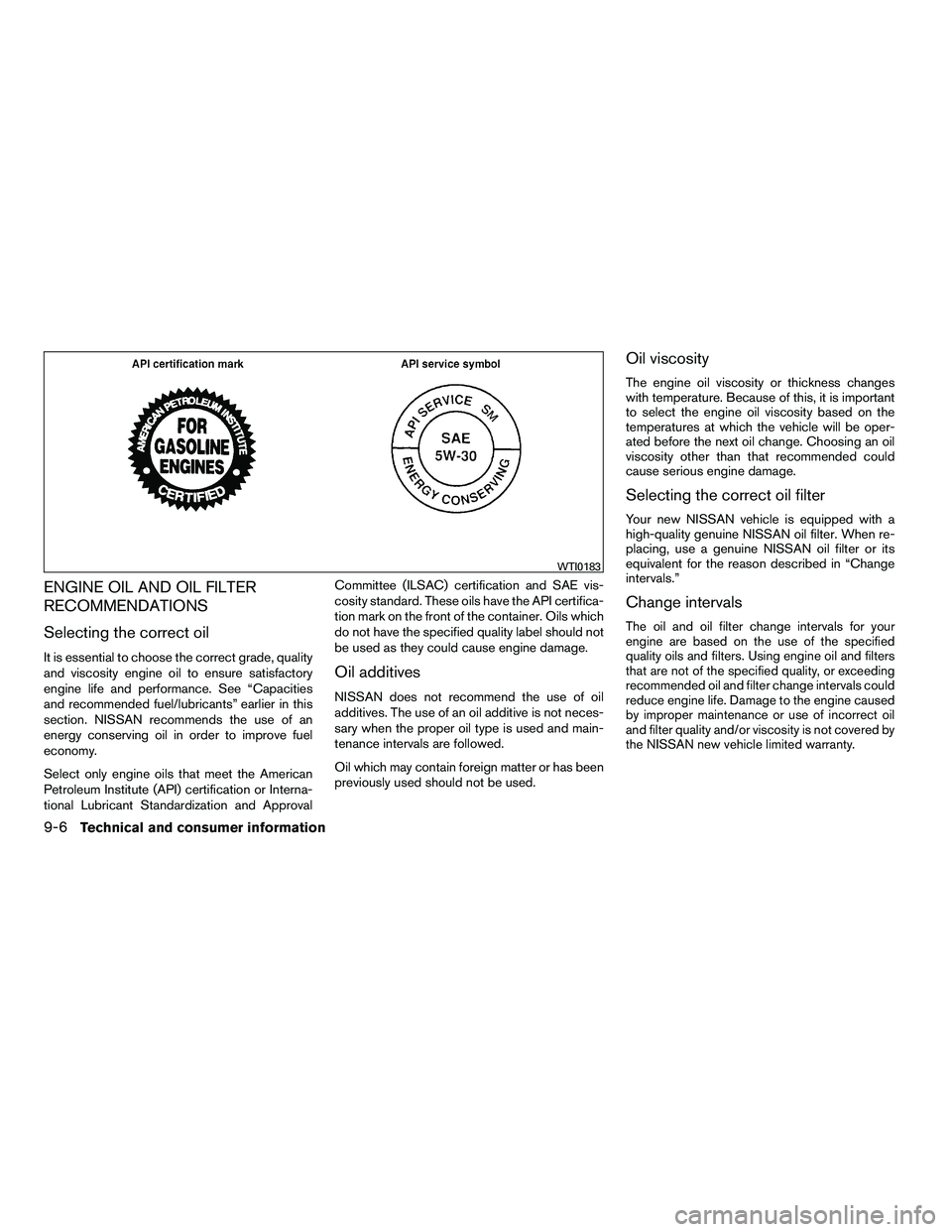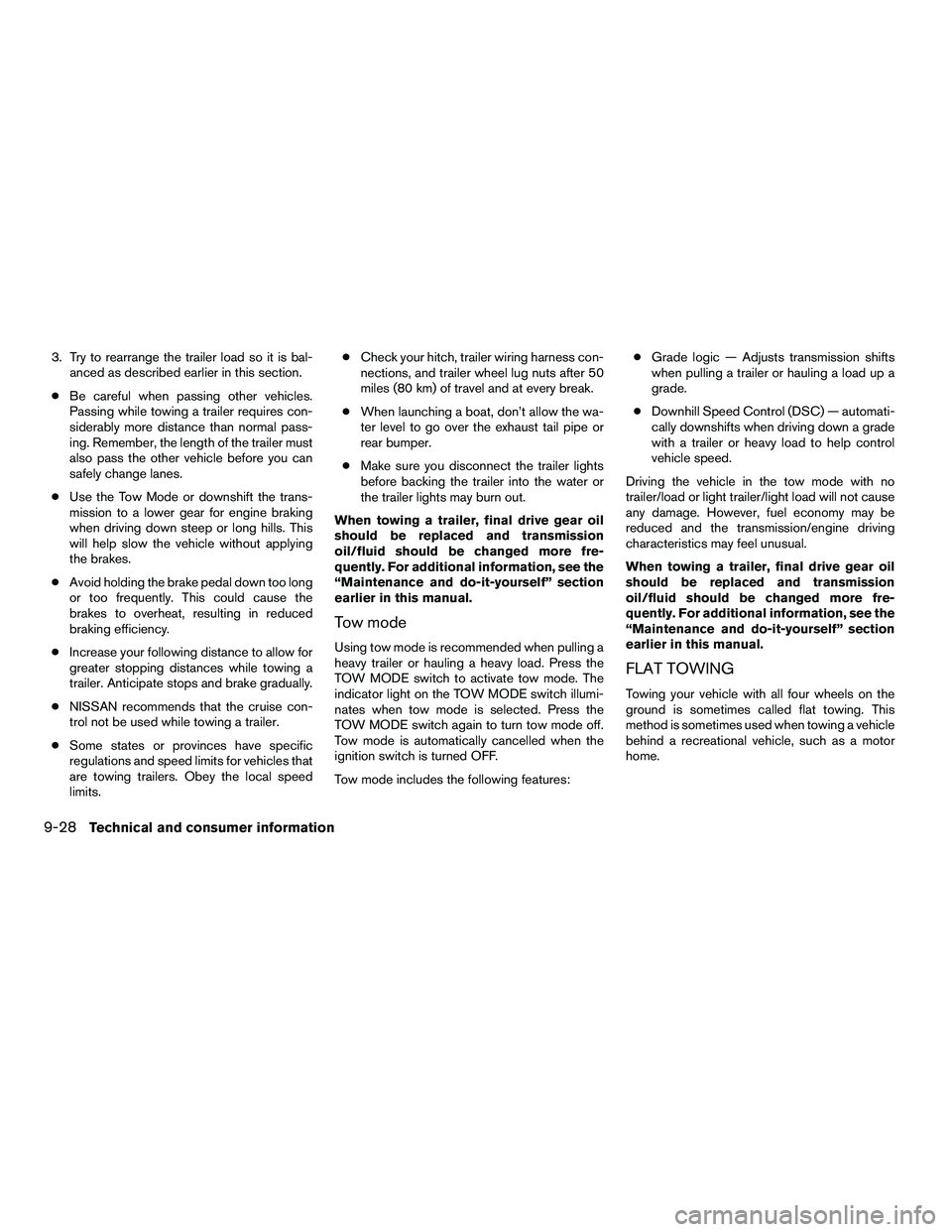Page 391 of 472
1. Battery
2. Fuse/fusible link box
3. Transmission dipstick
4. Engine oil filler cap
5. Brake fluid reservoir
6. Windshield washer fluid reservoir
7. Air cleaner
8. Drive belt location
9. Radiator cap
10. Power steering fluid reservoir
11. Engine oil dipstick
12. Engine coolant reservoir
NOTE:
Engine cover removed for clarity.
Page 394 of 472
5. Remove the dipstick again and check the oillevel. It should be between the H (High) and
L (Low) marks
�B. This is the normal oper-
ating oil level range. If the oil level is below
the L (Low) mark
�A, remove the oil filler cap
and pour recommended oil through the
opening. Do not overfill
�C.
6. Recheck oil level with the dipstick.
It is normal to add some oil between oil
maintenance intervals or during the
break-in period, depending on the severity
of operating conditions.
Page 395 of 472
If the oil filter is to be changed, remove and
replace it at this time. See “Changing engine
oil filter” later in this section.
● Waste oil must be disposed of prop-
erly.
● Check your local regulations.
Page 396 of 472
5. Wipe the engine oil filter sealing surface witha clean rag.
Page 435 of 472

ENGINE OIL AND OIL FILTER
RECOMMENDATIONS
Selecting the correct oil
It is essential to choose the correct grade, quality
and viscosity engine oil to ensure satisfactory
engine life and performance. See “Capacities
and recommended fuel/lubricants” earlier in this
section. NISSAN recommends the use of an
energy conserving oil in order to improve fuel
economy.
Select only engine oils that meet the American
Petroleum Institute (API) certification or Interna-
tional Lubricant Standardization and ApprovalCommittee (ILSAC) certification and SAE vis-
cosity standard. These oils have the API certifica-
tion mark on the front of the container. Oils which
do not have the specified quality label should not
be used as they could cause engine damage.Oil additives
NISSAN does not recommend the use of oil
additives. The use of an oil additive is not neces-
sary when the proper oil type is used and main-
tenance intervals are followed.
Oil which may contain foreign matter or has been
previously used should not be used.
Oil viscosity
The engine oil viscosity or thickness changes
with temperature. Because of this, it is important
to select the engine oil viscosity based on the
temperatures at which the vehicle will be oper-
ated before the next oil change. Choosing an oil
viscosity other than that recommended could
cause serious engine damage.
Selecting the correct oil filter
Your new NISSAN vehicle is equipped with a
high-quality genuine NISSAN oil filter. When re-
placing, use a genuine NISSAN oil filter or its
equivalent for the reason described in “Change
intervals.”
Change intervals
The oil and oil filter change intervals for your
engine are based on the use of the specified
quality oils and filters. Using engine oil and filters
that are not of the specified quality, or exceeding
recommended oil and filter change intervals could
reduce engine life. Damage to the engine caused
by improper maintenance or use of incorrect oil
and filter quality and/or viscosity is not covered by
the NISSAN new vehicle limited warranty.
Page 436 of 472
Your engine was filled with a high-quality engine
oil when it was built. You do not have to change
the oil before the first recommended change
interval. Oil and filter change intervals depend
upon how you use your vehicle.
Operation under the following conditions may
require more frequent oil and filter changes:● repeated short distance driving at cold out-
side temperatures
● driving in dusty conditions
● extensive idling
● towing a trailer
● stop and go commuting
Refer to the “NISSAN Service and Maintenance
Guide” for the maintenance schedule.
AIR CONDITIONER SYSTEM
REFRIGERANT AND OIL
RECOMMENDATIONS
The air conditioner system in your NISSAN
vehicle must be charged with the refriger-
ant HFC-134a (R-134a) and the oil, NISSAN
A/C system oil Type S or the exact equiva-
lents.
Page 457 of 472

3. Try to rearrange the trailer load so it is bal-anced as described earlier in this section.
● Be careful when passing other vehicles.
Passing while towing a trailer requires con-
siderably more distance than normal pass-
ing. Remember, the length of the trailer must
also pass the other vehicle before you can
safely change lanes.
● Use the Tow Mode or downshift the trans-
mission to a lower gear for engine braking
when driving down steep or long hills. This
will help slow the vehicle without applying
the brakes.
● Avoid holding the brake pedal down too long
or too frequently. This could cause the
brakes to overheat, resulting in reduced
braking efficiency.
● Increase your following distance to allow for
greater stopping distances while towing a
trailer. Anticipate stops and brake gradually.
● NISSAN recommends that the cruise con-
trol not be used while towing a trailer.
● Some states or provinces have specific
regulations and speed limits for vehicles that
are towing trailers. Obey the local speed
limits. ●
Check your hitch, trailer wiring harness con-
nections, and trailer wheel lug nuts after 50
miles (80 km) of travel and at every break.
● When launching a boat, don’t allow the wa-
ter level to go over the exhaust tail pipe or
rear bumper.
● Make sure you disconnect the trailer lights
before backing the trailer into the water or
the trailer lights may burn out.
When towing a trailer, final drive gear oil
should be replaced and transmission
oil/fluid should be changed more fre-
quently. For additional information, see the
“Maintenance and do-it-yourself” section
earlier in this manual.
Tow mode
Using tow mode is recommended when pulling a
heavy trailer or hauling a heavy load. Press the
TOW MODE switch to activate tow mode. The
indicator light on the TOW MODE switch illumi-
nates when tow mode is selected. Press the
TOW MODE switch again to turn tow mode off.
Tow mode is automatically cancelled when the
ignition switch is turned OFF.
Tow mode includes the following features: ●
Grade logic — Adjusts transmission shifts
when pulling a trailer or hauling a load up a
grade.
● Downhill Speed Control (DSC) — automati-
cally downshifts when driving down a grade
with a trailer or heavy load to help control
vehicle speed.
Driving the vehicle in the tow mode with no
trailer/load or light trailer/light load will not cause
any damage. However, fuel economy may be
reduced and the transmission/engine driving
characteristics may feel unusual.
When towing a trailer, final drive gear oil
should be replaced and transmission
oil/fluid should be changed more fre-
quently. For additional information, see the
“Maintenance and do-it-yourself” section
earlier in this manual.
FLAT TOWING
Towing your vehicle with all four wheels on the
ground is sometimes called flat towing. This
method is sometimes used when towing a vehicle
behind a recreational vehicle, such as a motor
home.
9-28Technical and consumer information
�REVIEW COPY—2010 Armada (wzw)
Owners Manual (owners)—USA_English (nna)
02/18/09—debbie
�
Page 465 of 472

Car phone or CB radio.............4-92
Cargo light ...................2-57
Cargo (See vehicle loading information) . . .9-13
CD care and cleaning .............4-71
CD changer (See audio system) ........4-50
CD player (See audio system) .........4-58
Child restraint with top tether strap ......1-37
Child restraints .......1-31, 1-31, 1-32, 1-34
Precautions on child restraints . . .1-32, 1-40, 1-45, 1-50
Top tether strap anchor point locations . .1-37
Child safety rear door lock ............3-7
Chimes, audible reminders ...........2-20
Cleaning exterior and interior ..........7-2
Clock ...................4-48, 4-56
(models with navigation system) . .4-11, 4-27
Clock set .................4-11, 4-27
C.M.V.S.S. certification label ..........9-11
Cold weather driving ..............5-33
Compact disc (CD) player ...........4-58
CompactFlash (CF) player ...........4-60
Console box ...............2-40, 2-46
Control panel buttons .............4-17
Brightness/contrast button .....4-16, 4-32
Enter button ..............4-2, 4-17
Setting button .............4-9, 4-26
Startup screen ...............4-20
Without navigation system ..........4-2
Controls Audio controls (steering wheel) ......4-73
Heater and air conditioner controls . . . .4-36
Rear audio controls .............4-75
Rear seat air conditioner ..........4-38
Coolant Capacities and recommended
fuel/lubricants .................9-2 Changing engine coolant
..........8-8
Checking engine coolant level ........8-7
Engine coolant temperature gauge .....2-6
Corrosion protection ...............7-5
Cruise control ..................5-18
Cup holders ...................2-44
Curtain
side-impact and rollover air bag . . .1-65
D
Daytime running light system
(Canada only) ..................2-32
Defroster switch Rear window and outside mirror defroster
switch ....................2-30
Digital video disc DVD .............4-76
Dimensions and weights .............9-9
Dimmer switch for instrument panel ......2-33
Display controls
(see control panel buttons) ........4-2, 4-17
Distance to empty .............4-5, 4-21
Door locks ....................3-5
Drive belt ....................8-16
Drive positioner, Automatic ...........3-36
Driving Cold weather driving ............5-33
Driving with automatic transmission . . . .5-14
Precautions when starting and driving . . .5-2
E
Economy - fuel .................5-20
Emission control information label .......9-11
Emission control system warranty .......9-30Engine
Before starting the engine .........5-12
Capacities and recommended
fuel/lubricants .................9-2
Changing engine coolant ..........8-8
Changing engine oil .............8-9
Changing engine oil filter ..........8-10
Checking engine coolant level ........8-7
Checking engine oil level ..........8-8
Engine compartment check locations . . . .8-6
Engine coolant temperature gauge .....2-6
Engine cooling system ............8-7
Engine oil ...................8-8
Engine oil and oil filter recommendation . .9-6
Engine oil viscosity ..............9-6
Engine serial number ............9-11
Engine specifications .............9-8
Starting the engine ............ .5-12
Engine oil pressure
gauge ............2-8
Engine oil pressure low/engine coolant
temperature high warning light .........2-15
Enter button ................4-2, 4-17
Event data recorders ..............9-32
Exhaust gas (Carbon monoxide) ........5-2
Eyeglass case ..................2-41
F
Flashers
(See hazard warning flasher switch) ......2-34
Flat tire ......................6-2
Floor mat positioning aid .............7-5
Fluid Brake fluid ..................8-12
10-2
�REVIEW COPY—2010 Armada (wzw)
Owners Manual (owners)—USA_English (nna)
03/09/09—tbrooks
�